30 November, 2003
Shackleton’s Nimrod Expedition and the Amundsen-Scott Race
for the Pole
Sunday morning “dawned” cloudy and windy, with a “Condition 3” notice
for McMurdo Station. There are three levels for weather conditions in
Antarctica. Condition 3 is a clear to overcast day with calm to light
winds, light precipitation, and good visibility. Condition 2 signifies
overcast conditions with precipitation, increasing wind strength and
limited visibility. Condition 1 is when Antarctica throws it all at you
– heavy precipitation, high winds, blowing and drifting snow, and
severely limited visibility. Travel is not restricted on base under
Conditions 3 and 2, but at Condition 1, personnel must stay wherever
they are until the weather clears. We’re at Condition 3 today and while
travel is not restricted, the snow is piling up outside and it is a good
day to sit with a cup of hot chocolate and write more about the Heroic
Age of Exploration.
Having fallen out with Scott during the 1901-1904 expedition (see
11/29/03 Heroic Age of Exploration – Scott’s Discovery
Expedition), Ernest Shackleton (Figure 1) launched his own polar
expedition aboard the Nimrod in 1907-1909. Despite a promise to
Scott that he would not return to McMurdo Sound (Figure 2), the weather
forced Shackleton back to Ross Island where he built a hut at Cape Royds
(Figure 3) in the shadow of Mt. Erebus (See 11/23/03 Penguin
Parade). Intending to stay for two years, provisions were
stockpiled around the hut (Figures 4) and the surplus can still be seen
there today.
In several harrowing escapes Shackleton and his men narrowly avoided
disaster during this expedition. On their return journey from the pole,
Shackleton and three of his men were near starvation when they stumbled
onto a large supply depot established by a team member who Shackleton
had previously disregarded as being useless and had assigned to work
with the dog team. It was this “misfit” teammate and his dog sled team
that made it possible for such a large food cache to be established,
saving Shackleton’s life. Later in the journey, as the four-man polar
team approached the coast, they were running behind schedule and barely
managed to catch their supply ship, which was preparing to leave that
same day.
Despite their failure, Shackleton’s team came within 97 miles of their
objective, the closest any team had come to the South geographic pole. A
second team of men from this expedition had, in fact, reached the South
magnetic pole and others in Shackleton’s party are credited with the
first ascent of Mt. Erebus. Considered to be an overall success, the
Nimrod expedition helped make Shackleton famous.
Despite their best efforts, both Scott and Shackleton were to be bested
in 1911 by Roald Amundsen (Figure 5) of Norway, who reached the South
geographic pole on December 14, only a month and four days ahead of
Scott on his second attempt. Amundsen used sled dogs and experienced
drivers, making no effort to hide his singular motive of reaching the
pole first, while Scott and Shackleton hauled loads with ponies (Figure
6) and manpower (Figure 7). Amundsen traveled quickly, allowing no time
for scientific studies, which flew in the face of the Congress’s
directive. But his method proved successful.
At the same time that Amundsen was blitzing his way to the South
geographic pole, Scott was making his second attempt. He had sailed into
McMurdo Sound on the Terra Nova, but could not reach “Discovery
Hut” built on his previous expedition, so he established a new hut at
Cape Evans (Figure 8). A five-man team, including Scott, set out for the
pole while the rest of the crew awaited his return. To occupy their
time, the team at Cape Evans conducted a wide array of scientific
studies including collecting gravity, magnetic, auroral and
meteorological observations. Meanwhile, Scott’s team reached the pole on
January 18, 1912, only to find that Amundsen had arrived one month
earlier. Dispirited (Figure 9), the polar team turned around and headed
back to Cape Evans. Members of Scott’s team who had been waiting at Cape
Evans traveled the 30 miles back to Discovery Hut where they would climb
Observation Hill, the highest point (230 m or 755 ft) in the area other
than Mt. Erebus, to look for Scott’s return. However, Scott and his
polar team had succumbed to frostbite and fatigue on their return
journey. Scott’s journal recounted their last days, ravaged by
starvation, snow blindness and frostbite only 11 miles from a food depot
and less than 100 miles from Cape Evans: “We knew that poor Oates was
walking to his death, but though we tried to dissuade him, we knew it
was the act of a brave man and an English gentleman. We all hope to meet
the end with a similar spirit and assuredly the end is not far.” Scott
was referring to the fact that Oates, suffering from severely
frostbitten feet, had walked out of his tent in his socks to die alone,
rather than be a burden to his friends who wouldn’t leave him behind to
save themselves. Scott’s own journal entries stop on March 29^th with
“It seems a pity, but I do not think I can write more – R. Scott.” Three
of the five bodies from Scott’s party were discovered eight months
later, huddled in their tent. Oates’s and Evan’s bodies were never
recovered. A cross was later erected on Observation Hill in memory of
the five men, one of many crosses commemorating the lives lost to
Antarctic exploration.
With Scott dead and Amundsen having claimed the pole for Norway,
Shackleton had to set his sights on a new goal – a Trans-Antarctic
Crossing.
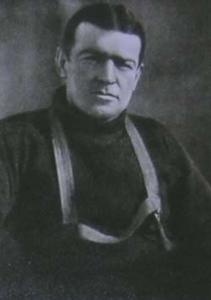
1. Figure 1 – Ernest Shackleton, an injured member of Scott’s 1901-1904 expedition, made a name for himself with his 1907-1909 Nimord expedition that failed to reach the South geographic pole, but successfully achieved the magnetic pole and the first ascent of Mt. Erebus.

2. Figure 2 – Map of Ross Island. Shackleton and Scott’s huts dot the coastline from McMurdo to Cape Royds.
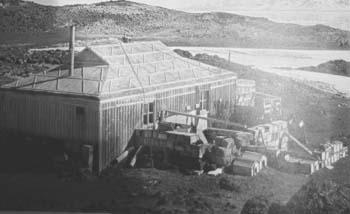
3. Figure 3a – Shackleton’s Hut at Cape Royds as seen in 1907.
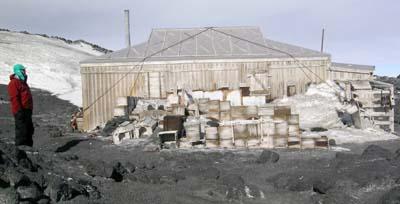
4. Figure 3b – Shackleton’s Hut at Cape Royds as seen in 2003. The crates stacked in the foreground of the photo are the remains of the pony stable and garage for the Arrol-Johnston motor car. Dirt-filled crates were stacked to create wall and the roof was covered with a tarp.

5. Figure 4 – As Shackleton had intended to stay in Antarctica for two years, a surplus of provisions were stacked outside the hut. Jars of salt and rusted cans of beans and dried meat are still visible in the snow.
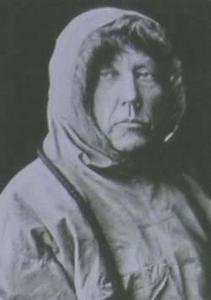
6. Figure 5 – Roald Amundsen of Norway was the first man to reach the South geographic pole in 1911, beating Robert F. Scott by one month. Amundsen’s use of experienced dog mushers and outerwear modeled after the Eskimo’s loose-fitting fur-lined clothing allowed him to travel quickly and warmly. Scott’s reliance on ponies and his efforts to conduct scientific research on the way to the pole may be what cost him the race and his life.
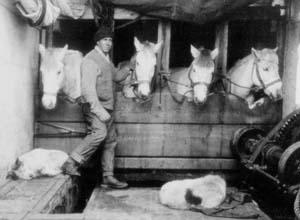
7. Figure 6 – Scott opted to utilize ponies to haul his sleds. This proved to be one of Scott’s downfalls as the ponies could not be taken up on the Beardmore Glacier, leaving the men to haul gear for the next 1000 miles.
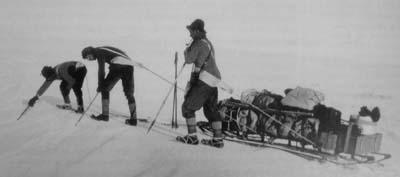
8. Figure 7 – Reliance on man-hauling was a necessity when the ponies failed. Scott had declined to use sled dogs arguing that “No journey ever made with dogs can approach the height of that fine conception which is realized when a party of men go forth to face hardship, dangers and difficulties with their own unaided efforts… and succeed in solving some problem of the great unknown… Surely in this case the conquest is more nobly and splendidly won.” One of Scott’s own men wrote that man-hauling was “the most-backbreaking work I have ever come up against.”

9. Figure 8a – Insulation was tacked onto the Cape Evans hut in 1911.

10. Figure 8b – Members of the 2003-2004 Mt. Erebus team standing in front of the Cape Evans hut. This photo is taken from the same angle as Figure 8a. Note the later addition of the large vestibule over the small, framed entrance seen in Figure 8a. We are standing on a snowdrift that has piled above the stack of bales seen above.
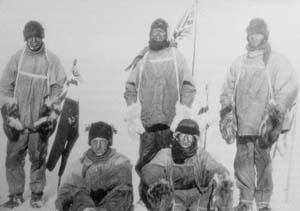
11. Figure 9 – The pole team consisted of Captain Oates, Lieutenant Bowers, Captain Robert F. Scott, Dr. Wilson, and Petty Office Evans. Having been beaten to the pole by Amundsen, who arrived only one month earlier, was disheartening and Scott wrote “Great God! This is an awful place and terrible enough for us to have labored to it without the reward of priority!”
Contact the TEA in the field at
.
If you cannot connect through your browser, copy the
TEA's e-mail address in the "To:" line of
your favorite e-mail package.
|
